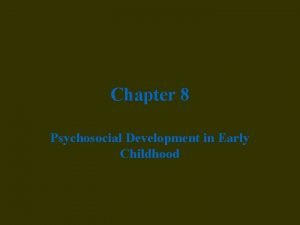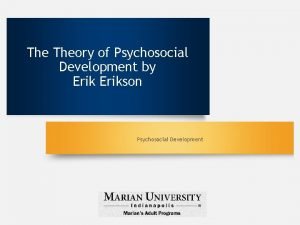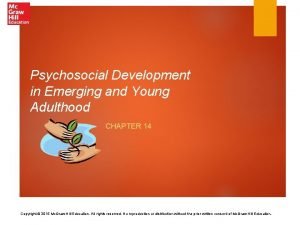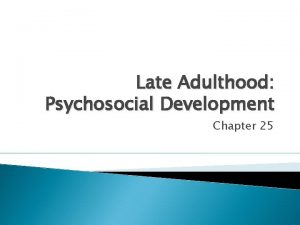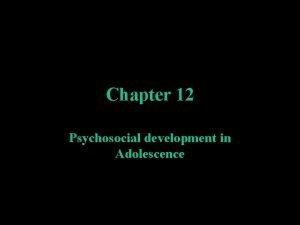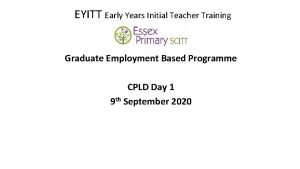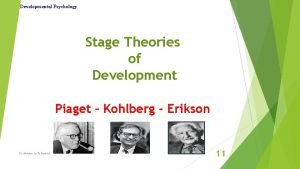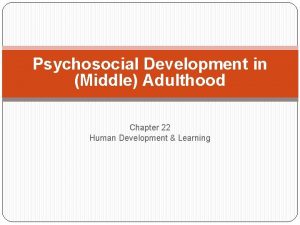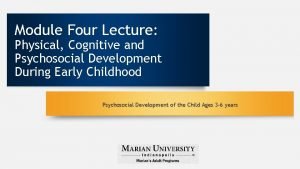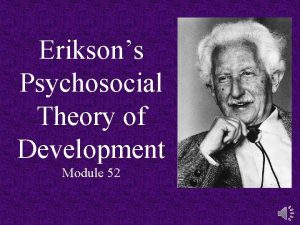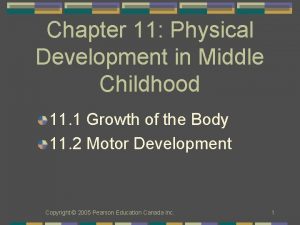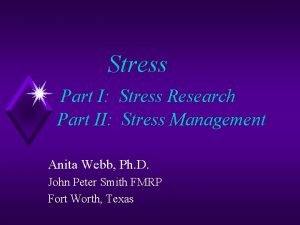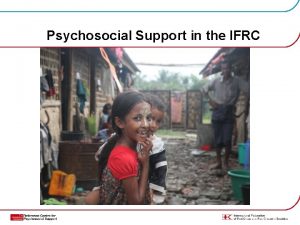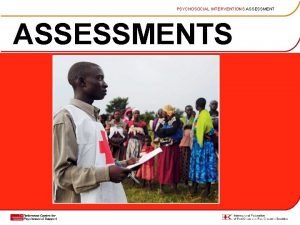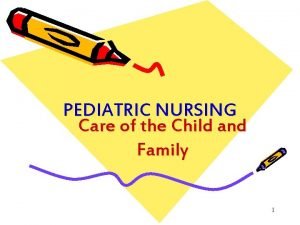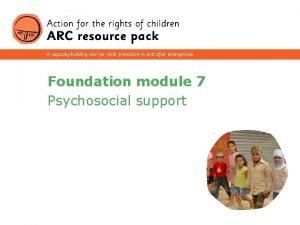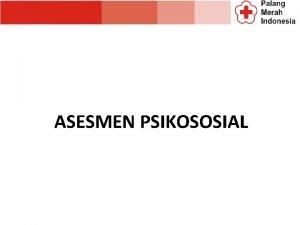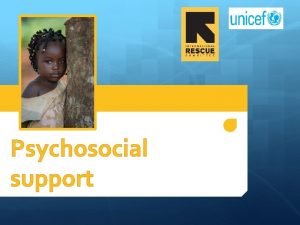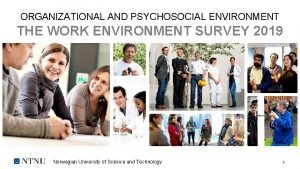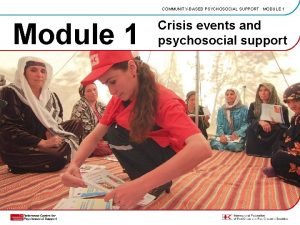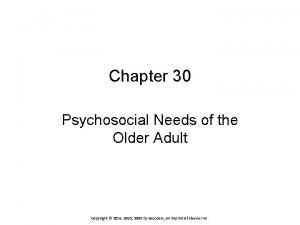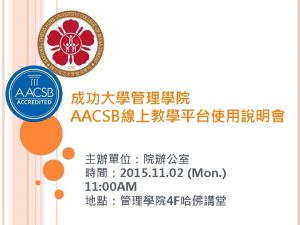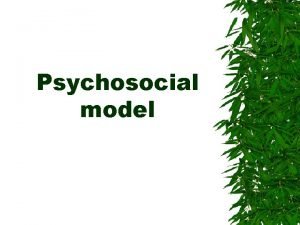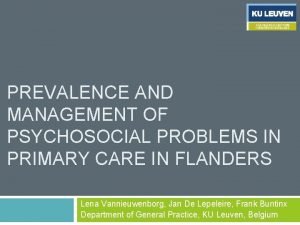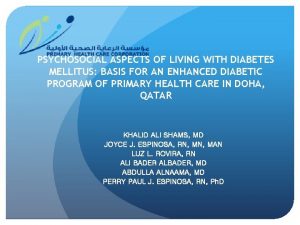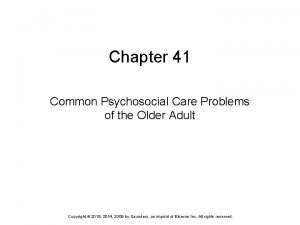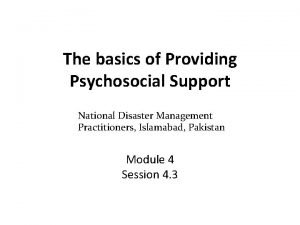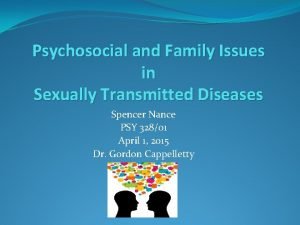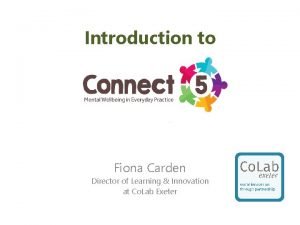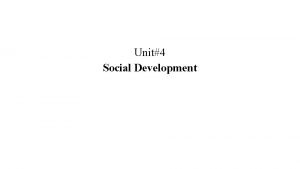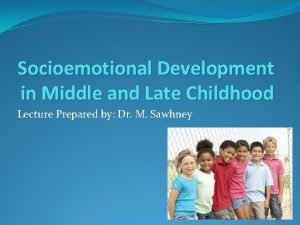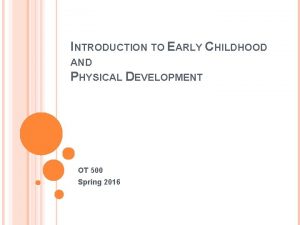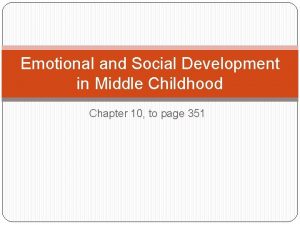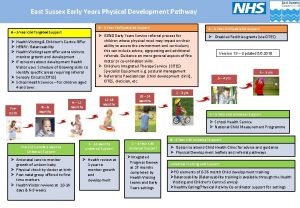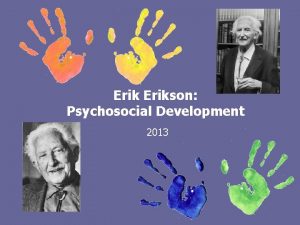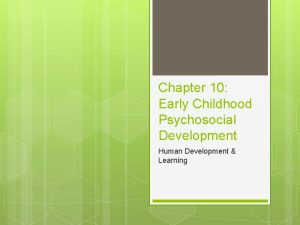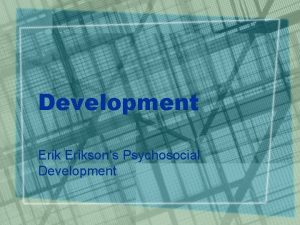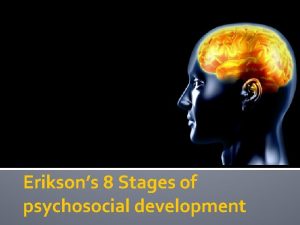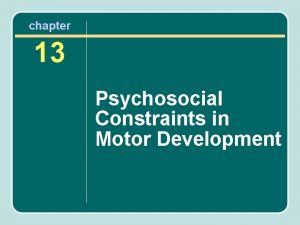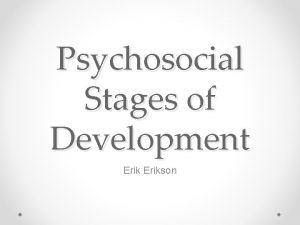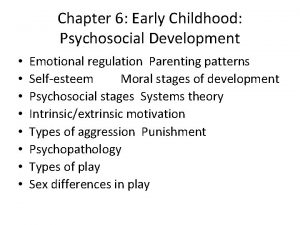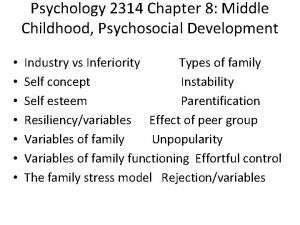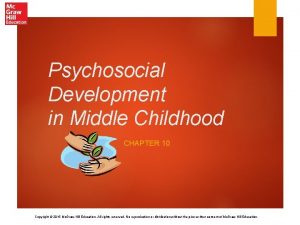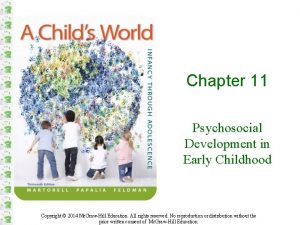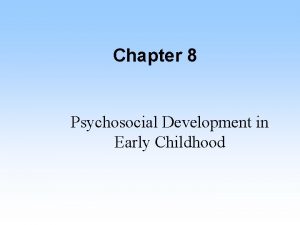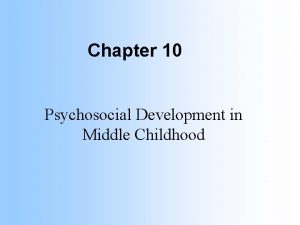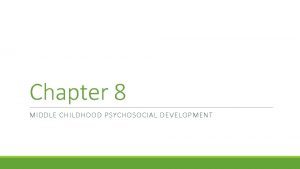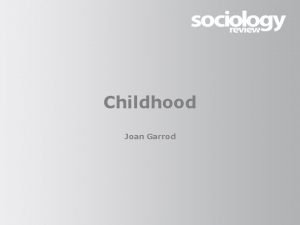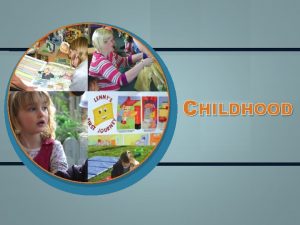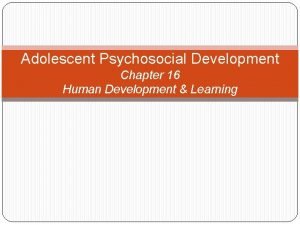MidLate Childhood Psychosocial Development Chapter 13 Human Development

















































- Slides: 49

Mid-Late Childhood Psychosocial Development: Chapter 13 Human Development & Learning

Hail Mary, full of grace! The Lord is with thee; blessed art thou among women, and blessed is the fruit of thy womb, Jesus. Holy Mary, Mother of God, pray for us sinners now and at the hour of our death. Amen.

The Nature of the Child

Erikson’s Psychosocial Crises Age Crisis I (0 -1) trust vs mistrust Relations Themes mother to get, to give in return Virtue Malignancies HOPE sensory maladjustment -withdrawal autonomy vs to hold on, to impulsivity -shame and parents WILL let go compulsion doubt III (3 -6) initiative vs to play, to go PURPOSE ruthlessness— Family/siblings preschool guilt after (courage) inhibition IV (7 -12 or so) to complete, to Industry vs. Neighborhood narrow virtuosity school-age make things COMPETENCE inferiority /school -inertia child together II (2 -3) -toddler

Erikson’s Insights Industry versus inferiority • The fourth of Erikson’s eight psychosocial crises • Children attempt to master many skills, developing a sense of themselves as either industrious or inferior, competent or incompetent.

Industry and Inferiority • Industrious children at this age actively master culturally valued skills and abilities (e. g. reading, math, collecting, categorizing, counting) • Children work on regulating their temper • Effortful control: The ability to regulate one’s emotions and actions through effort, not simply through natural inclination.

Freud on Latency • Latency: • Emotional drives are quiet and unconscious sexual conflicts are submerged. • Children acquire cognitive skills and assimilate cultural values by expanding their world to include teachers, neighbors, peers, club leaders, and coaches. • Sexual energy is channeled into social concerns.

Self-Concept • Shift in self-understanding from the physical to the psychological • A 6 -year old may describe herself as “a fast runner and good at drawing” • An 11 -year-old will describe herself as “pretty smart, friendly , and helpful to my friends. ” • As they get older, children discover their strengths and weaknesses. • School-age children recognize themselves as individuals, distinct from what their parents think of them

Self-Concept Social comparison • Comparing one’s attributes to those of other people • Helps children value themselves and abandon the imaginary, rosy selfevaluation of preschoolers.

Self-esteem • • An individual’s overall and specific self-evaluation. More emotionally oriented. Self-criticism and self-consciousness rise from ages 6 to 11 Materialism increases; self-esteem dips


Coping and Overcoming Resilience: The capacity to adapt well despite significant adversity and to overcome serious stress. Important: 1. Resilience is dynamic - a person may be resilient at some periods but not at others. 2. Resilience is a positive adaptation to stress - if rejection by a parent leads a child to establish a closer relationship with another adult, that child is resilient. 3. Adversity must be significant - Resilient children overcome conditions that overwhelm many of their peers.

Cumulative Stress

Gathering Strengths • • • Child’s working model Developing friends, activities, and skills School success and after-school activities Community, church, and government programs Education Easygoing temperament and high IQ • Being academically gifted is NOT essential for resilience.

Social Support and Religious Faith • A network of supportive relatives is a better buffer than having only one close parent. • Grandparents, teachers, unrelated adults, peers, and pets can lower stress. • Community institutions (e. g. churches, libraries) can also be crucial sources of social support.

Families and Children Shared and Nonshared Environments • Environment: • Influence of shared environment (e. g. , children raised by the same parents in the same home) shrinks with age • Effect of nonshared environment (e. g. , friends or schools) increases

Families and Children • Children raised in the same households by the same parents do not necessarily share the same home environment. • Changes in the family affect every family member differently (e. g. depending on age and/or gender). • Most parents respond to each of their children differently.

Family Function and Family Structure Family function: The way a family works to meet the needs of its members. Children need families to: 1. provide basic material necessities 2. encourage learning 3. help them develop self-respect 4. nurture friendships 5. foster harmony and stability

Family Function and Family Structure Family structure: The legal and genetic relationships among relatives living in the same home; includes nuclear family, extended family, stepfamily, and so on.


Households • Household: Composed of people who live together in the same home • Two or more people who are related to one another (most common) • One person living alone • Nonrelatives living together • Family household: Includes a least one parent and at least one child under age 18 • Accounts for about two-thirds of the households in the United States

Two-Parent Families • Nuclear family: A family that consists of a father, a mother, and their biological children under age 18. • Tend to be wealthier, better educated, healthier, more flexible, and less hostile • Biological parents tend to be very dedicated to their offspring • Similar advantages occur for children who are adopted

Stepfamilies • Stepparent must find a role that is not as intimate as that of the biological parents but that allows some involvement with the children. • Easier if the children are young (under age 3) • Difficult if the children are teenagers • Blended family: A stepparent family that includes children born to several families, such as the biological children from the spouses’ previous marriages and the biological children of the new couple. • • Tend to be wealthier than single-parent families Dissolve more often than do first marriages Jealousy, stress and conflict can arise Adjust to the authority of another adult

Single-Parent Families • Single-parent family: A family that consists of only one parent and his or her children under age 18. • Children in single-mother families fare worse in school and in adult life than most other children. • Single-mother households are often low-income and unstable, move more often and add new adults more often. • Single-fathers have a slightly higher income and tend to be slightly older than single mothers.

Many Relatives at Home • Extended family: A family consisting of parents, their children, and other relatives living in one household. • Polygamous family: A family consisting of one man, several wives, and the biological children of the man and his wives.

Cultural Differences in Family Structure

Family Trouble • Dysfunctional family: A family that does not support all its members • Three factors increase the likelihood of dysfunction: 1. 2. 3. Low Income Instability Low Harmony

Low Income • Family stress model: the crucial question to ask about any risk factor (e. g. poverty, divorce, job loss, eviction) is whether or not it increases the stress on a family • The family-stress model contends that the adults’ stressful reaction to poverty is crucial in determining the effect on the children. • Also reaction to wealth…

Instability • Children in middle childhood prefer continuity • Upsetting changes include moving to a new home, being sent to a new school, and changes in the family structure) • Changing neighborhoods is stressful. Growing self-awareness makes it harder to make new friends. • Disruptions correlated negatively with income. • Adults might not realize that these transitions affect schoolchildren

Harmony • Children feel a need for harmony • Parents who habitually fight are more likely to divorce, move, and otherwise disrupt the child’s life. • In general, a child’s interpretation of a family situation, determines how that situation affects him/her. (social-cognitive connection)

Harmony • The more important correlate with children’s psychological and academic correlate was not the severity of the marital strife, but the children’s feelings of self-blame or vulnerability. • In general, children feel much less vulnerable if they feel they have some control over family circumstances.


The Consequences of Divorce • Only half of children in the U. S. will pass through childhood living with both parents each of whom has been married only once • School-age children tend to blame themselves for the breakup

After the divorce/separation… • Both children and parents may show several types of psychological maladjustments for 6 months to 2 years • • Anxiety Depression Sleep disturbances Phobias

Rediscovering the Status Quo • After 18 months to 2 years, most children return to their predivorce psychological adjustment • Twice as many children of divorced parents require psychological counseling as do children from intact families • For some children, living in a home with unhappy marriage and which is high in conflict has stronger negative consequences than divorce • How children react to divorce depends on several factors, one of which is economic standing of the family the child is living with.

The Peer Group • Culture of children: The particular habits, styles, and values that reflect the set of rules and rituals that characterize children as distinct from adult society. • Fashion • Language

Friendship • School-age children value personal friendship more than peer acceptance. • Gender differences • Girls talk more and share secrets. • Boys play more active games. • Friendships lead to psychosocial growth and provide a buffer against psychopathology.

Friendship Older children: • Demand more of their friends • Change friends less often • Become more upset when a friendship ends • Find it harder to make new friends • Seek friends who share their interests and values

Friendship • Avoidance of opposite sex becomes very pronounced during middle childhood • Children’s friendships are almost entirely sex-segregated • When sexes interact it is called “border work”, is often romantic, and helps emphasize clear boundaries between sexes

Social Awareness • Social cognition: The ability to understand social interactions, including the causes and consequences of human behavior. • Begins in infancy and continues to develop in early childhood • Social cognition is well established by middle childhood • Children with impaired social cognition are likely to be rejected

Rejected Children • Aggressive-rejected children: Children who are disliked by peers because of antagonistic, confrontational behavior • Withdrawn-rejected children: Children who are disliked by peers because of their timid, withdrawn, and anxious behavior • Neglected: ignored but not shunned.

Bullying SCHOOL- THE BULLY • 160, 000 U. S. schoolchildren stay home from school each day because they are afraid of being bullied • About 10 to 15 percent of students bully others at one time or another. • Roots of bullying seem to be a combination of nature and nurture. Families that provide insecure attachment, stressful homes, ineffective discipline, or hostile siblings intensify children’s aggression.

Bullies and Victims • Bullying: Repeated, systematic efforts to inflict harm through physical, verbal, or social attack on a weaker person. • Bully-victim: Someone who attacks others and who is attacked as well • Also called a provocative victim because he or she does things that elicit bullying, such as stealing a bully’s pencil

Successful Efforts to Eliminate Bullying • The whole school must be involved, not just the identified bullies. • Intervention is more effective in the earlier grades. • Evaluation of results is critical.


Heinz’ Dilemma • A woman was near death from a special kind of cancer. There was one drug that the doctors thought might save her. It was a form of radium that a druggist in the same town had recently discovered. The drug was expensive to make, but the druggist was charging ten times what the drug cost him to produce. He paid $200 for the radium and charged $2, 000 for a small dose of the drug. The sick woman's husband, Heinz, went to everyone he knew to borrow the money, but he could only get together about $1, 000 which is half of what it cost. He told the druggist that his wife was dying and asked him to sell it cheaper or let him pay later. But the druggist said: “No, I discovered the drug and I'm going to make money from it. ” So Heinz got desperate and broke into the man's store to steal the drug for his wife. Should Heinz have broken into the laboratory to steal the drug for his wife? Why or why not? [1]

Morality in Middle Childhood KOHLBERG’S LEVELS OF MORALITY Lawrence Kohlberg (1963): Described stages of morality that stem from three levels of moral reasoning, with two stages at each level 1. Preconventional moral reasoning: Emphasizes rewards and punishments 2. Conventional moral reasoning: Emphasizes social rules 3. Postconventional moral reasoning: Emphasizing moral principles

Criticisms of Kohlberg • Kohlberg ignored culture and gender. • Kohlberg’s levels could be labeled personal (preconventional), communal (conventional), and worldwide (postconventional) family is not included. • The participants in Kohlberg’s original research were all boys.

What Children Value • Children develop their own morality, guided by peers, parents and culture • Concrete operational cognition gets them to think about morality and to try to be ethical. • When child culture conflicts with adult morality, children often align themselves with peers.
 Psychosocial development in early childhood
Psychosocial development in early childhood Principles of growth and development
Principles of growth and development Erikson's psychosocial theory
Erikson's psychosocial theory Infancy psychosocial development
Infancy psychosocial development Psychosocial development in young adulthood
Psychosocial development in young adulthood Late adulthood psychosocial development
Late adulthood psychosocial development Initiative vs guilt
Initiative vs guilt Generativity stage
Generativity stage Psychosocial development in adolescence
Psychosocial development in adolescence Erickson's psychosocial theory of development
Erickson's psychosocial theory of development Early adulthood emotional development 19-45
Early adulthood emotional development 19-45 Erikson's psychosocial theory of development
Erikson's psychosocial theory of development Permaparenting
Permaparenting Define physical cognitive and psychosocial development
Define physical cognitive and psychosocial development Trust vs. mistrust
Trust vs. mistrust Chapter 10:3 psychosocial changes of aging
Chapter 10:3 psychosocial changes of aging Human needs and human development
Human needs and human development Chapter 8 human needs and human development
Chapter 8 human needs and human development Early childhood is ____ for language learning
Early childhood is ____ for language learning Physical development in middle childhood chapter 11
Physical development in middle childhood chapter 11 Relaxation response technique
Relaxation response technique Psychosocial environment
Psychosocial environment Types of psychosocial support
Types of psychosocial support Psychosocial information
Psychosocial information Psychosocial tasks
Psychosocial tasks 7 psychosocial support
7 psychosocial support Erikson's psychosocial crisis
Erikson's psychosocial crisis Asesmen psikososial
Asesmen psikososial Types of psychosocial support
Types of psychosocial support Psychosocial and aesthetic factors
Psychosocial and aesthetic factors Psychosocial environment meaning
Psychosocial environment meaning Types of psychosocial support
Types of psychosocial support Psychosocial needs of the elderly
Psychosocial needs of the elderly World association for psychosocial rehabilitation
World association for psychosocial rehabilitation Interdependence is a psychosocial concept
Interdependence is a psychosocial concept Definition of psychosocial problems
Definition of psychosocial problems Psychosocial aspects of living with diabetes
Psychosocial aspects of living with diabetes Common psychosocial care problems of the elderly
Common psychosocial care problems of the elderly Types of psychosocial support
Types of psychosocial support Psychosocial issues
Psychosocial issues Fiona
Fiona Human development index definition ap human geography
Human development index definition ap human geography Social development in infancy and childhood
Social development in infancy and childhood Middle & late childhood
Middle & late childhood Cognitive development in middle and late childhood
Cognitive development in middle and late childhood Ap psych schema
Ap psych schema Fine motor skills development in early childhood
Fine motor skills development in early childhood Social development in middle adulthood
Social development in middle adulthood Social and emotional development in middle childhood
Social and emotional development in middle childhood Physical development in early childhood
Physical development in early childhood
